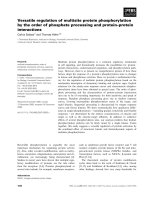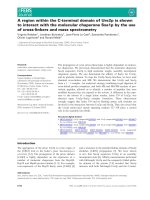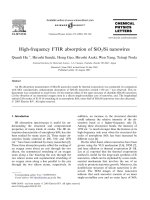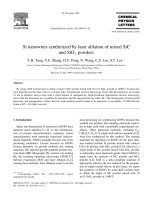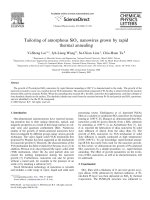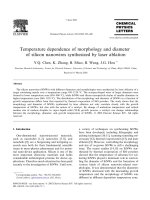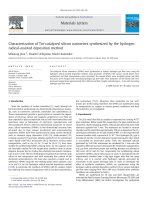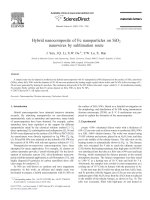- Trang chủ >>
- Khoa Học Tự Nhiên >>
- Vật lý
Si nanowires synthesized by laser ablation of mixed sic and sio2 powders
Bạn đang xem bản rút gọn của tài liệu. Xem và tải ngay bản đầy đủ của tài liệu tại đây (387.9 KB, 5 trang )
26 November 1999
Ž.
Chemical Physics Letters 314 1999 16–20
www.elsevier.nlrlocatercplett
Si nanowires synthesized by laser ablation of mixed SiC
and SiO powders
2
Y.H. Tang, Y.F. Zhang, H.Y. Peng, N. Wang, C.S. Lee, S.T. Lee
)
()
Center of Super-Diamond and AdÕanced Films COSDAF and Department of Physics and Materials Science,
City UniÕersity of Hong Kong, Hong Kong, China
Received 22 July 1999; in final form 12 September 1999
Abstract
By using a KrF excimer laser to ablate a target of SiC powder mixed with 10 wt.% SiO powder at 14008C, Si nanowires
2
were deposited on the inner wall of a ceramic tube. Transmission electron microscopy shows that the nanowires are around
14 nm in diameter and co-exist with a small amount of nanoparticles. High-resolution transmission electron microscopy
shows that the nanowires are crystalline Si nanowires and the nanoparticles are cubic SiC. The intergrowth of heterocrystal
nanowires and nanoparticles verifies that the oxide-assisted growth model of Si nanowires is reasonable. q 1999 Elsevier
Science B.V. All rights reserved.
1. Introduction
Ž.
Quasi one-dimensional Si nanowires SiNW have
wx
attracted much attention 1–4 . As the miniaturiza-
tion of present microelectronics continues, future
nanoelectronics need nanoscale functional semicon-
ductor materials. SiNWs naturally become one of the
promising candidates. Current research on SiNWs
focuses primarily on growth methods and starting
materials. The reported growth methods include elec-
Ž. wx
tron beam EB lithography 5 , reactive ion etching
wx Ž.wx
6 , the scanning tunneling microscope STM 7 ,
wx wx
thermal evaporation 8,9 and laser ablation 1,2 .
Among these methods, laser ablation seems to be the
)
Corresponding author. Fax: q852-2788-7830; e-mail:
most promising for synthesizing SiNWs because this
method can produce free-standing nanoscale materi-
als in high yield with controllable experimental con-
ditions. Other nanoscale materials, including C
60
wx wx wx
10 , b-C N 11 , single-wall carbon nanotubes 12 ,
34
were first synthesized by this method. The starting
materials for deposition of SiNWs by the laser abla-
tion method include Si powder mixed with catalyst
wx w x
1 or Si powder with SiO powder 13 . However, a
2
target made of SiC powder mixed with SiO powder
2
Ž.
is interesting since electronic-grade silicon EGS is
made from the reaction of SiC powder and SiO
2
wx
powder 14 . EGS is a polycrystalline material of
high purity which is the raw material for the prepara-
tion of single-crystal silicon. In this Letter, we report
the synthesis of SiNWs by using KrF excimer laser
to ablate the target of SiC powder mixed with 10
wt.% SiO powder at 14008C.
2
0009-2614r99r$ - see front matter q 1999 Elsevier Science B.V. All rights reserved.
Ž.
PII: S0009-2614 99 01119-7
()
Y.H. Tang et al.r Chemical Physics Letters 314 1999 16–20 17
2. Experimental
A schematic diagram of the equipment used is
shown in Fig. 1. The target was made by pressing
SiC powder mixed with 10 wt.% SiO at 1508C for
2
24 h under a hydraulic press. After the target was
placed in the high-temperature zone inside the ce-
ramic tube, the tube was evacuated by a mechanical
rotary pump. Argon gas was kept flowing through
Ž
the tube at a rate of 50 sccm standard cubic cen-
.
timeter and a pressure of 700 Torr. After the tem-
perature achieved 14008C, the laser ablation process
Ž.
was started. A KrF excimer laser beam 248 nm of
400 mJ per pulse and a pulse width of 34 ns at 10 Hz
ablated the target. The total duration of ablation was
2 h and the size of the laser spot on the target was
about 1= 3 mm. Two layers of sponge-like webs, a
yellow web and a green web, were deposited on the
inner wall of the tube as shown in Fig. 1. The yellow
web was 5 times more abundant than the green web
by weight. The products were mounted on copper
Ž.
grids for transmission electron microscopy TEM
Ž.
observations Philips FEGCM200 .
3. Results and discussion
The TEM micrograph in Fig. 2a shows the typical
morphology of the materials in the yellow web. It
can be seen that the product consists of nanowires
with an average diameter of 14 nm. Most of the
SiNWs are consist of straight and smoothly curved
parts. The morphology is a common characteristic of
wx
various nanowires, such as SiC nanowires 15 and
wx
carbon nanowires 16 . Although the nanowires have
a high ratio of length to diameter, the diameter
remains the same throughout the entire nanowire.
The inset is a selected-area electron diffraction
Fig. 1. The schematic diagram of the laser ablation apparatus.
Fig. 2. Morphology of Si nanowires taken from the yellow
Ž.
product. a Low-magnitude TEM image of Si nanowires. The
Ž.
inset is SAED pattern. b HRTEM image of a typical Si nanowire.
wx
The growth direction goes along 111 .
Ž.
SAED pattern taken from the nanowires. The
Ž.Ž.
diffraction rings match well with the 111 , 220
Ž.
and 311 diffraction rings of silicon with a diamond
structure. Analysis using energy dispersive X-ray
Ž.
spectroscopy EDS equipped on TEM confirmed
that the nanowires have a crystalline Si core and an
amorphous silicon oxide outer layer. Fig. 2b is a
Ž.
micrograph of high-resolution TEM HRTEM of a
typical SiNW. It further confirms that the nanowires
are crystalline SiNWs. Two groups of crystal lattices
have the angle in 708 which means the spots con-
Ä4
sisted by 111 crystalline planes. Thus the growth
wx
direction is along 111 .
In addition to the yellow web as the main product,
there still exists a green web, which has not been
()
Y.H. Tang et al.r Chemical Physics Letters 314 1999 16–2018
Fig. 3. TEM images of the green web in which Si nanowires
Ž.
coexist with SiC nanoparticles. a Small amount of SiC nanopar-
Ž.
ticles which attach Si nanowires. The inset is SAED pattern. b
Ä4
HRTEM image of the b-SiC nanoparticles. The fringes are 111
lattice planes with a spacing of 0.25 nm.
found in the SiNWs products by using other starting
wx
materials 13 . The results of HRTEM show that the
green web is a mixture of SiNWs and cubic SiC
Ž.
b-SiC nanoparticles as shown in Fig. 3a. Fig. 3a
shows that some nanoparticles co-exist with the Si
nanowires. The sizes of the nanoparticles range from
several nanometers to 80 nm. The nanoparticles pos-
sess irregular outlines. The inset SAED pattern shows
Ž.
there are two sets of rings. One consists of the 111 ,
Ž. Ž.
220 and 311 rings of silicon. The other corre-
Ž.Ž. Ž.
sponds to the 111 , 220 and 311 rings of b-SiC.
This confirms that the sample is a mixture of SiNWs
and b-SiC. The results of HRTEM show that the
nanowires are SiNWs as shown in Fig. 2b. The
nanoparticles are b-SiC nanoparticles whose typical
morphology are shown in Fig. 3b. In this figure, the
Ä4
fringes are 111 crystalline planes with a lattice
spacing of 0.25 nm. This value fits with the standard
Ä4
111 crystalline plane of b-SiC. Grain boundaries
and microtwins are the main defects observed.
The results of XRD and Raman analysis also give
the same conclusions. Fig. 4a shows the XRD spec-
trum of the green product. The XRD measurements
was carried out by using Cu Ka radiation at room
temperature in a Siemens D500 system. The spec-
trum shows two sets of peaks. One set consists of the
Ž.Ž. Ž.
111 , 220 and 311 peaks of Si which are from
Ž.Ž.
the SiNWs. The other set consists of the 111 , 220
Ž.
and 311 peaks of b-SiC which are from the b-SiC
nanoparticles. The positions of the peaks fit the
wx
values in the standard XRD handbook 17 . The
Raman scattering measurement was performed at
room temperature using a micro-Raman Renishaw
2000 system with 1 cm
y1
resolution and 0.4 cm
y1
Fig. 4. The spectrum of X-ray diffraction and the Raman spectrum
recorded from the green web.
()
Y.H. Tang et al.r Chemical Physics Letters 314 1999 16–20 19
reproducibility. The excitation source was the 514.5
nm line of an argon ion laser with a spot size of 10
mm in diameter and a power of 4 mW. The Raman
result is shown in Fig. 4b. The peak at 780 cm
y1
is
wx
the characteristic peak of b-SiC 18 . The other peak
at 950 cm
y1
is second-order peak of Si. The peak of
SiC is asymmetric. This is possibly due to the
wx
nanoscale size effect of the SiC nanoparticles 19,20 .
We propose that the growth mechanism of the Si
nanowires can be explained by the oxide-assisted
wx
growth model 8,13 recently proposed by us. In this
model, a liquid SiO layer was formed on the tip of
the Si nanowire. It is this SiO liquid layer which
assists the nanowire growth. In the present case, SiO
came from the chemical reaction between SiC and
SiO . Analogous to the synthesis of industrial sili-
2
wx
con, the overall reaction 14 was
SiC solid qSiO solid
Ž. Ž.
2
sSi solid qSiO gas q CO gas .
Ž . Ž. Ž.
The reaction was activated by the excimer laser. The
SiO vapor was carried by the flowing gas and de-
posited forming Si nanowires according to the
wx
oxide-assisted growth model 8,13 .
It should be mentioned that no SiC nanowires
were found in the product. Moreover, the b-SiC
nanoparticles were only formed inside the second
Ž.
web green web . Since no b-SiC nanoparticles can
Ž.
be found in the first web yellow web , it implies
that the b-SiC nanoparticles were also grown by the
vapor reaction and not by direct ablation. Otherwise,
they should also be formed inside the first web
which was closer to the target. Their growth only
inside the second web may be due to the suitable
growth temperature. b-SiC nanoparticles can be
readily formed by the chemical reaction between SiO
and CO. Unlike Si which grows as the one-dimen-
sional nanowires, b-SiC can not grow one-dimen-
sionally but remain as three-dimensional nanoparti-
cles. We suspect that this is probably due to the fact
that b-SiC can not form a semi-melting phase at the
Ž.
relatively low temperature ; 9508C . According to
wx
the oxide-assisted growth model 8,13 , one-dimen-
sional growth became impossible without the liquid
phase at the tip. This opinion can be understood by
comparing the Fig. 3b with Fig. 2b. As we can see,
the outer shells of the two materials are obviously
different. The Si nanowire shown in Fig. 2b has a
thick amorphous silicon oxide outer layer which is
formed from the semi-melting SiO layer. However,
the b-SiC nanoparticle shown in Fig. 3b has nearly
no amorphous outer layers. So the one-dimensional
growth of b-SiC can not be achieved.
4. Conclusions
We have synthesized Si nanowires from SiC pow-
ders mixed with SiO powders which are used to
2
synthesize single crystalline silicon in the present
semiconductor industry. The crystalline Si nanowires
are around 14 nm in diameter and co-exist with
small amounts of b-SiC nanoparticles. The growth
of the nanowires is proposed to be via the intermedi-
ate material SiO which was generated by the chemi-
cal reaction between SiC and SiO . The experimen-
2
tal results indicate that the reaction to synthesizing
industrial silicon can also be that of Si nanowires.
This experiment also gives support to the oxide-as-
sisted growth model of SiNWs.
Acknowledgements
Financial support by the Research Grants Council
of Hong Kong under Grant No. 9040365 is gratefully
acknowledged.
References
wx Ž.
1 A. Morales, C.M. Lieber, Science 279 1998 208.
wx
2 Y.F. Zhang, Y.H. Tang, N. Wang, D.P. Yu, C.S. Lee, I.
Ž.
Bello, S.T. Lee, Appl. Phys. Lett. 72 1998 1835.
wx
3 N. Wang, Y.H. Tang, Y.F. Zhang, D.P. Yu, C.S. Lee, I.
Ž.
Bello, S.T. Lee, Chem. Phys. Lett. 283 1998 368.
wx
4 Y.H. Tang, Y.F. Zhang, C.S. Lee, N. Wang, D.P. Yu, I.
Ž.
Bello, S.T. Lee, Mat. Res. Soc. Symp. Proc. 526 1998 73.
wx
5 E. Leobandung, L. Guo, S.Y. Chou, Appl. Phys. Lett. 67
Ž.
1997 938.
wx
6 H. Namastsu, Y. Takahashi, M. Nagase, K. Murase, J. Vac.
Ž.
Sci. Technol. B 13 1995 2532.
wx Ž.
7 T. Ono, H. Saitoh, M. Esashi, Appl. Phys. Lett. 70 1997
1852.
wx
8 N. Wang, Y.H. Tang, Y.F. Zhang, C.S. Lee, S.T. Lee, Chem.
Ž.
Phys. Lett. 299 1999 237.
()
Y.H. Tang et al.r Chemical Physics Letters 314 1999 16–2020
wx
9 D.P. Yu, Z.G. Bai, Y. Ding, Q.L. Hang, H.Z. Zhang, J.J.
Wang, Y.H. Zou, W. Qian, G.C. Xiong, H.T. Zhou, S.Q.
Ž.
Feng, Appl. Phys. Lett. 72 1998 3458.
wx
10 H.W. Kroto, J.R. Heath, S.C. O’Brien, R.F. Curl, R.E.
Ž.
Smalley, Nature 318 1985 62.
wx Ž.
11 C. Niu, Y.Z. Lu, C.M. Lieber, Science 216 1993 334.
wx
12 T. Guo, P. Nikolave, A.G. Rinzler, D. Tomanek, D.T. Col-
Ž.
bert, R.E. Smalley, Chem. Phys. Lett. 243 1995 49.
wx
13 N. Wang, Y.H. Tang, Y.F. Zhang, C.S. Lee, S.T. Lee, Phys.
Ž.
Rew. B 58 1998 16024.
wx
14 S.M. Sze, VLSI Technology, McGraw–Hill Book, New York,
1983, p. 10.
wx
15 G.W. Meng, L.D. Zhang, Y. Qin, F. Philipp, S.R. Qiao,
Ž.
H.M. Guo, S.Y. Zhang, Chin. Phys. Lett. 689 1998 15.
wx
16 Y.H. Tang, N. Wang, Y.F. Zhang, C.S. Lee, I. Bello, S.T.
Lee, unpublished.
wx
17 International Center for Diffraction Data, Powder Diffraction
Database, Pennsylvania, PA, 1997.
wx
18 Z.C. Feng, A.J. Mascarenhas, W.J. Choyke, J.A. Powell, J.
Ž.
Appl. Phys. 64 1988 3176.
wx Ž.
19 I.H. Campbell, P.M. Fauchet, Solid State Commun. 58 1984
739.
wx Ž.
20 G. Nolsson, G. Nelin, Phys. Rev. B 6 1972 3777.
